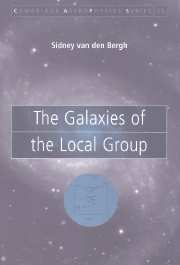Book contents
- Frontmatter
- Contents
- Preface
- 1 Introduction
- 2 Local Group membership
- 3 The Andromeda galaxy (M31)
- 4 The Milky Way system
- 5 The Triangulum galaxy (M33)
- 6 The Large Magellanic Cloud
- 7 The Small Magellanic Cloud
- 8 The elliptical galaxy M32 (= NGC 221)
- 9 The irregular dwarf galaxy NGC 6822
- 10 The starburst galaxy IC 10
- 11 Faint dwarf irregular galaxies
- 12 Spheroidal galaxies
- 13 The most luminous dwarf spheroidal galaxies
- 14 Dwarf spheroidals in the Andromeda subgroup
- 15 Faint dwarf spheroidals
- 16 The outer fringes of the Local Group
- 17 Intergalactic matter in the Local Group
- 18 Dynamical and physical evolution
- 19 Properties of the Local Group
- 20 Conclusions
- Glossary
- Bibliography
- Object Index
12 - Spheroidal galaxies
Published online by Cambridge University Press: 22 August 2009
- Frontmatter
- Contents
- Preface
- 1 Introduction
- 2 Local Group membership
- 3 The Andromeda galaxy (M31)
- 4 The Milky Way system
- 5 The Triangulum galaxy (M33)
- 6 The Large Magellanic Cloud
- 7 The Small Magellanic Cloud
- 8 The elliptical galaxy M32 (= NGC 221)
- 9 The irregular dwarf galaxy NGC 6822
- 10 The starburst galaxy IC 10
- 11 Faint dwarf irregular galaxies
- 12 Spheroidal galaxies
- 13 The most luminous dwarf spheroidal galaxies
- 14 Dwarf spheroidals in the Andromeda subgroup
- 15 Faint dwarf spheroidals
- 16 The outer fringes of the Local Group
- 17 Intergalactic matter in the Local Group
- 18 Dynamical and physical evolution
- 19 Properties of the Local Group
- 20 Conclusions
- Glossary
- Bibliography
- Object Index
Summary
The present section will deal with the three most luminous Local Group spheroidal galaxies: NGC 205, NGC 185, and NGC 147, all of which are companions to the Andromeda galaxy. These galaxies, which are too luminous to be called dwarf spheroidals (dSph), will be designated spheroidals (Sph). In the past such objects have been classified as being of types dE, Ep, S1, or dE/dSph. It should, however, be emphasized that Sph and dSph galaxies are, respectively, the bright and faint representatives of the same morphological class of galaxies.
NGC 147 and NGC 185 are located at only 0.22 Mpc from our adopted center of the Local Group. This places them closer to the center of mass of the Local Group than any other presently known Group members.
The spheroidal galaxy NGC 205
Introduction
The luminosity of NGC 205 is similar to that of M32. However, it has a much more extended structure. Furthermore M32 rotates, but NGC 205 does not (Bender, Paquet & Nieto 1991). A good photograph of NGC 205 is shown in the Hubble Atlas of Galaxies (Sandage 1961). Images taken in the ultraviolet (Baade 1951) show it to contain a small number of young blue stars. Deep exposures (see Figure 12.1) reveal some extended patches of dust absorption. Moreover, inspection of the image of NGC 205 on the prints of the Palomar Sky Survey, or deeper plates (see, for example, Fig. 7 of Kormendy 1982), clearly show that the outer isophotes of this galaxy are distorted – presumably due to the tides exerted by M31, from which it is separated by only 37′(8.2 kpc).
- Type
- Chapter
- Information
- The Galaxies of the Local Group , pp. 205 - 218Publisher: Cambridge University PressPrint publication year: 2000

